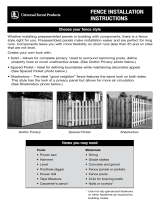
Setting posts
Install end and corner posts first. Tie a string between
the posts along the fence line. This establishes a refer-
ence, ensuring the posts are in line (Fig. 3). Brace the
posts using 2x4s nailed to both the posts and stakes in
the ground. This will keep them straight while the
concrete sets. Check for plumb (90º angle) on two
adjacent sides prior to pouring concrete. Fill holes with
ready-mix concrete following the package instructions.
Tamp the concrete to remove any air pockets. Overfill
the holes at the top and slope the concrete away
from the post to keep water from collecting around it.
Recheck plumb and alignment of all posts and allow
concrete to cure for 24 to 48 hours.
Cutting the posts to the proper height
An easy method to ensure your post tops are level is
to run a string from corner post to corner post at the
desired height, keeping the string taut (Fig. 3). Mark
each post at the string line and cut off the tops of the
posts. Finish off your posts with one of our decorative
finial tops.
Installing panels and pickets
For pre-assembled fence panels, use 18d to 20d nails
to attach them to the posts. If possible, pre-drill holes
through the panels to minimize any splitting from using
such a large nail.
To install loose pickets to backer rails, use 8d or 10d
box nails. Start at one end of the rail and check for level
and plumb every three or four pickets. If you wish to
build a solid “privacy” fence, butt the pickets without
leaving a gap in between. To build a spaced picket
fence, cut a board the width of the desired gap and
use it as a spacer. Remember to check for plumb every
few pickets. Use three backer rails for fences 6' tall
and higher and two rails for shorter fences. Backer rails
should be attached on edge
to prevent sagging.
Connecting backer
rails to posts
There are many ways to
attach backer rails or
stringers to the posts
(Fig. 4).
Place a board under pre-assembled panels to use as
a lever to adjust the panel to the proper height on the
post. All backer rails should run the same measurement
to the ground and to each other on a horizontal plane,
regardless of minor grade changes. Your finished prod-
uct will be much more appealing to the eye if proper
attention is given to this detail.
Gate installation
• Determine the swing direction (left- or right-hand
open).
• Mount hinge hardware to gate frame at the proper
height, pre-drilling all screw holes.
• Mount gate to gate post, pre-drilling all screw holes.
• Check for full gate swing clearance.
• Mount latch hardware, pre-drilling all screw holes.
Finishing your fence/initial maintenance
Applying a protective finish is recommended to prolong
the life of your fence. The type of finish will be deter-
mined by the look desired and the wood species used.
There are three options in finishing treatments: stain,
paint and waterproofing sealer. Clean your fence with a
cleaner/brightener that contains a mildewcide, prior to
applying your finish.
• Stain provides a durable finish coat while maintaining
the natural look of wood. A semitransparent stain is
recommended for new fences. It gives an even appear-
ance and hint of color while allowing the grain to show
through.
• Paint adds color as it protects and seals the fence.
The color can easily be coordinated with your home.
Clean, dry and prime with oil-based primer prior to
painting thefence. A durable exterior latex paint is
recommended.
• Waterproofing sealer is best for woods that are not
naturally resistant to decay or are exposed to
weather. The sealer helps prevent rain and moisture
from soaking into the wood. Choose one with a UV
stabilizer to slow the discoloration process.
Care and maintenance
• Continuous changes in weather conditions are hard
on your fence. Your maintenance plan must be
geared toward combating problems caused by water
absorption and loss, mildew growth and UV discolor-
ation.
• First-year maintenance – Reapply cleaner/brightener
as described in initial maintenance, as well as your
method of finish (paint, stain or water sealer). This
should be completed after 12 months.
• Future periodic preventive maintenance – Depending
on the location of your fence with regard to direct sun
exposure, foliage coverage, etc., it may be sufficient
to clean/brighten and recoat every two years. A
power washer may be necessary to properly clean
your fence.
Planning and Installing Your Fence, continued
Fig.4
Face Nailed
Toe Nailed
Mortise & Tenon
Fig.3
WOOD FENCING
7471_10/13







